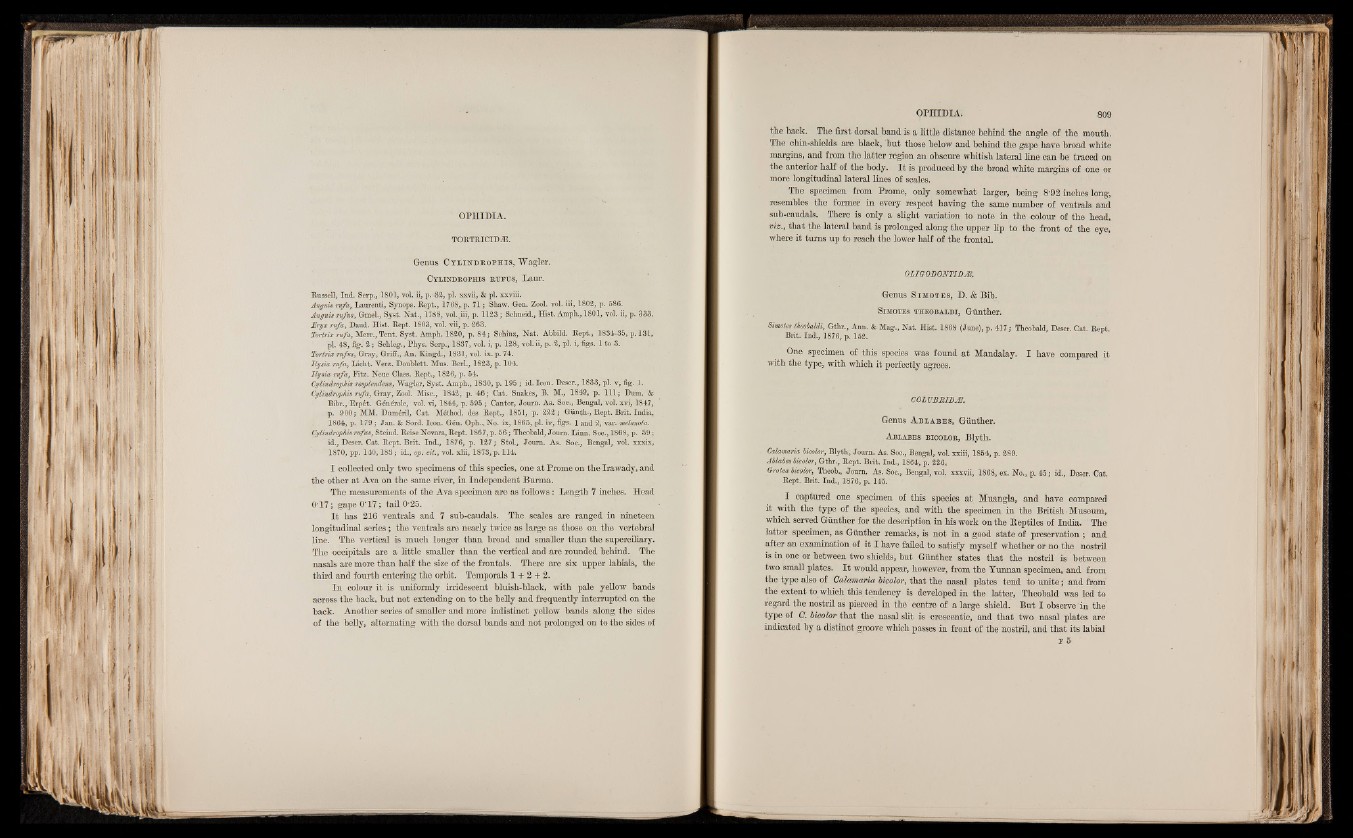
OPHIDIA.
TORTRICIDÆ.
Genus C y l i n d r o p h i s , Wagler.
C y l in d r o p h i s r t j f u s , Laur.
Russell, Ind. Serp., 1801, vol. ii, p. 32, pi. xxvii, & pi. xxviii.
Anguis rufa, Laurenti, Synops. Rept., 1768, p. 71 ; Shaw. Gen. Zool. vol. iii, 1802, p. 586.
Anguis rufus, Gmel., Syst. Nat., 1788, vol.,iii, p. 1128 ; Schneid., Hist. Amph., 1801, vol. ii, p. 333.
JSryx rufa, Daud. Hist. Rept. 1803, vol. vii, p. 263.
Tortrix rufa, Merr., Tent. Syst. Amph. 1820, p. 84; Schinz, Nat. Abbild. Rept., 1834-85, p. 131,
pi. 48, fig. 2 ; Schleg., Phys. Serp., 1837, vol. i, p. 128, vol.ii, p.-2, pi. i, figs. 1 to 8.
Tortrix rufus, Gray, Griff., An. Kingd., 1881, vol. ix. p. 74.
Ilysia rufa, Licht. Verz. Doublett. Mus. Berl., 1828, p. 104.
Ilysia rufa, Fitz. Neue Class. Rept., 1826, p. 54.
Cylindrophis resplendens, Wagler, Syst. Amph., 1880, p. 195 ; id. Icon. Descr., 1833, pi. v, fig. 1.
Cylindrophis rvfa, Gray, Zool. Misc., 1842, p. 46; Cat. Snakes, B. M., 1849, p. I l l ; Dum. &
Bibr., Erpét. Générale, vol. vi, 1844, p. 595 ; Cantor, Journ. As. Soc., Bengal, vol. xvi, 1847,
p. 900; MM. Dumézil, Cat. Method, des Rept., 1851, p. 222; Günth., Rept. Brit. India,
1864, p. 179 ; Jan. & Sord. Icon. Gen. Oph., No. ix, 1865, pi. iv, figs. 1 and 2, var. melanota.
Cylindrophis rufus, Steind. Reise Novara, Rept. 1867, p. 56 ; Theobald, Joum. Linn. Soc., 1868, p. 39 ;
id., Descr. Cat. Rept. Brit. Ind., 1876, p. 127; Stol., Journ. As. Soc., Bengal, vol. xxxix,
1870, pp. 140,183; id., opi cit., vol. xlii, 1873, p. 114.
I collected only two specimens of this species, one at Prome on the Irawady, and
the other at Ava on the same river, in Independent Burma.
The measurements of the Ava specimen are as follows : Length 7 inches. Head
0T7 ; gape 0T7 ; tail 0-25.
I t has 216 ventrals and 7 suh-caudals. The scales are ranged in nineteen
longitudinal series ; the ventrals are nearly twice as large as those on the vertebral
line. The vertical is much longer than broad and smaller than the superciliary.
The occipitals are a little smaller than the vertical and are rounded behind. The
nasals are more than half the size of the frontals. There are six upper labials, the
third and fourth entering the orbit. Temporals 1 + 2 + 2.
In colour it is uniformly irridescent bluish-black, with pale yellow bands
across the back, but not extending on to the belly and frequently interrupted on the
back. Another series of smaller and more indistinct yellow bands along the sides
of the belly, alternating with the dorsal bands and not prolonged on to the sides of
the back. The first dorsal band is a little distance behind the angle of the mouth.
The chin-shields are black, but those below and behind, the gape have broad white
margins, and from the latter region an obscure whitish lateral line can be traced on
the anterior half of the body. I t is produced by the broad white margins of one or
more longitudinal lateral lines of scales.
The specimen from Prome, only somewhat larger, being 8*92 inches long,
resembles the former in every respect having the same number of ventrals and
sub-caudals. There is only a slight variation to note in the colour of the head,
viz., that the lateral band is prolonged along thé upper lip to the front of the eye,
where it turns up to reach the lower half of the frontal.
OLIGODONT1DM.
Genus S im o t e s , D. & Bib.
S im o t e s t h e o b a l d i , Günther.
Simotes theobaldi, Gthr., Ann. & Mag., Nat. Hist. 1868 (June), p. 417; Theobald, Descr. Cat. Rept.
Brit. Ind., 1876, p. 152.
One specimen of this species was found at Mandalay. I have compared it
with the type, with which it perfectly agrees.
COLUBMD2E.
Genus A b l a b e s , Günther.
A b l a b e s b ic o l o r , Blyth.
Calamaria bicolor, Blyth, Journ. As. Soc., Bengal, vol. -rrin, 1854, p. 289.
Ablabes bicolor, Gthr., Rept. Brit. Ind., 1864, p. 226.
Grotea bicolor, Theob., Journ. As. Soc., Bengal, vol. xxxvii, 1868, ex. No., p. 45; id., Descr. Cat.
Rept. Brit. Ind., 1876, p. 145.
I captured one specimen of this species at Muangla, and have compared
it with the type of the species, and with the specimen in the British Museum,
which served Günther for the description in his work on the Beptiles of India. The
latter specimen, as Günther remarks, is not in a good state of preservation ; and
after an examination of it I have failed to satisfy myself whether or no the nostril
is in one or between two shields, but Günther states that the nostril is between
two small plates. I t would appear, however, from the Yunnan specimen, and from
the type also of Calamaria bicolor, that the nasal plates tend to unite; and from
the extent to which this tendency is developed in the latter, Theobald was led to
regard the nostril as pierced in the centre of a large shield. But I observe in the
type of C. bicolor that the nasal slit is crescentic, and that two nasal plates are
indicated by a distinct groove which passes in front of the nostril, and that its labial
f 5